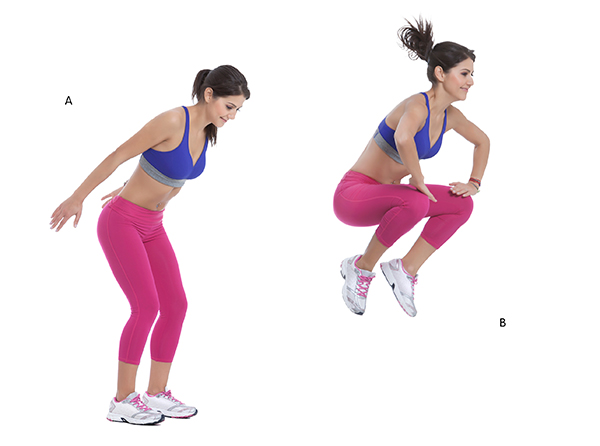 Description
Description
The knee tuck jump or the knee-to-chest jump aims to target balance and to improve agility and stability. It also helps in increasing your vertical high jump, and you would be able to develop core strength by utilizing your own body weight. This particular movement is used as a training exercise for gymnasts and athletes to ameliorate their performance. Knee tuck jump is efficient in burning out unwanted fats as long as you abide with the right angle and posture in jumping. It is a challenging exercise for your torso to gain upper body strength and for your knees to be more flexible.
This exercise is done by standing on both of your feet and bending your knees slightly. Then fully bend your knees, making it into a squat position. Pull your knees toward your chest or jump having your knees reach your chest. The point of this exercise is to have your knees or your thighs touch your torso.
Results
The muscles that the knee tuck jump targets are the quadriceps (the core muscles in front of the thigh), the hamstrings (the muscles at the back of the thigh), and the gluteal muscles (the prevailing muscles that cover up the whole buttocks).
This exercise is deemed effective in lifting your gluteal muscles, leaving your buttocks firm and in full shape. Your quadriceps and hamstrings are going to be more flexible, preventing the chances of muscle strain and the inability to bend at full angle. Knee tuck jump also helps in building up knee joints, which are essential in bending.
Sets and Repetitions
For beginners, jumping can be tiresome, which is why a 2 to 4 repetitions of jump is sufficed. For non-beginners, a total of 8 to 12 sets of jump is completed. After each set, a 60-second rest is required for your knee muscles to recuperate. The quadriceps and the hamstrings usually get strained if you overdo this exercise.
Related Movements
A workout program is comprised of various exercises that are integrated to achieve the desired goal for the body; may it be to stay toned or to lose weight. As for the knee tuck jump, related exercises are jogging, push-ups, side planking, burpees and bicycle crunches.
Related Foods
Since you are going to jump through this movement, you may want to eat less so that you wouldn’t feel nauseated during the jump. But of course, you need food that provides you with the energy you wholly need to support you throughout the exercise. You can begin with meals like oatmeal with blueberries, Greek yoghurt and nuts, banana, and a whole grain toast. These simple foods contain sufficient amount of carbohydrates that your body necessitates to carry on with the knee tuck jump. After the jump, you can eat protein-rich foods to help with the repair of your burn-out muscles—foods such as avocados, omelet with carrots and peas, sweet potatoes and salmon, and chicken breasts.
Celebrity Use
Being a television host, journalist and a professional wrestler, Maria Menounos has been busy with her own workout routines. Knee tuck jump, together with a sprawl, is a part of her exercise regime by performing two sets of 10 repetitions. She incorporates the knee tuck jump because it greatly contributes to the development of the core strength and to the increase of power in her knees and legs.
Functional Use
You would recognize improvements when you are burning out calories with all the jumping. Since this exercise is taking advantage of your body weight, you would feel that your torso is strengthening and is toning. Your hips would have much more defined shape and your buttocks is lifted and plumped. Your legs are going to be much stronger and flexible due to the jumping. In your daily physical activities, you would be feeling light especially when you run because your legs have gained power and strength.